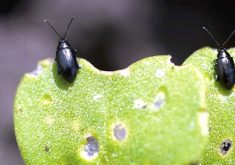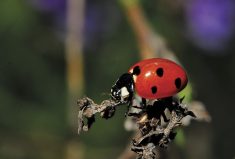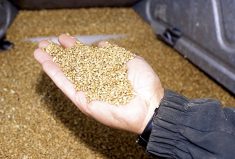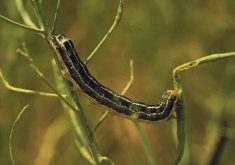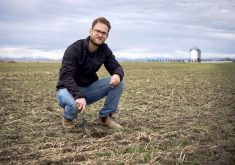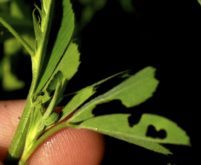Alberta has released its 2024 survey maps for three of canola’s hungriest insect pests: Bertha armyworm, cabbage seedpod weevil and grasshoppers.
All three pest populations were relatively small, although hot spots appeared throughout the province. In all three cases, releases from Alberta Agriculture and Irrigation emphasized scouting and when to do so for best results.
Bertha armyworm
Read Also
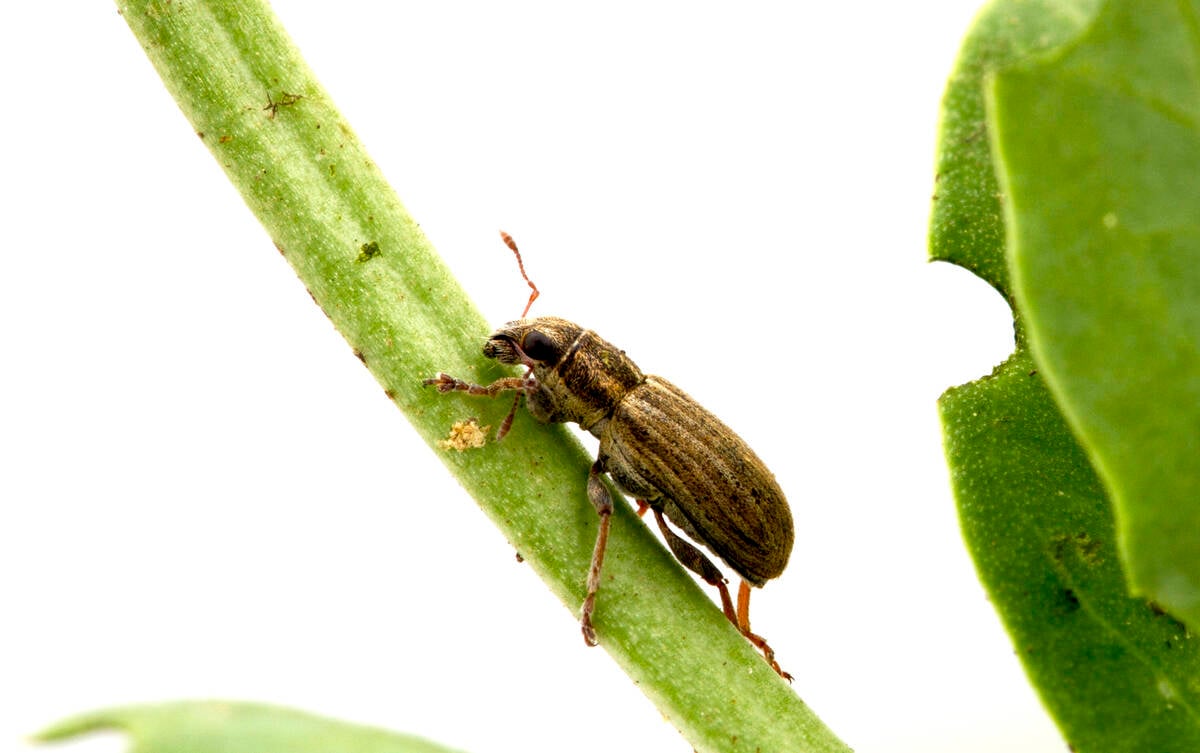
Growers urged to monitor for pea leaf weevil despite low 2025 activity
The pea leaf weevil has moved north in Alberta, but the outlook for damage from the insect is 2026 is promising.
Based on the 2024 moth catch, there appears to be no threat in the coming season but appearances can be deceiving and the type of winter could make a big difference.
“Snow cover encourages successful overwintering (in Bertha armyworm). In contrast, low snow cover with cold temperatures reduces winter survival,” read the media release.
The Alberta Bertha Armyworm Monitoring Program celebrated 29 years in 2024. It has grown to include a partnership among agronomists, agricultural fieldmen and farmers who maintain the pheromone trap network.
Alberta Agriculture organizes the network and maintains the map and the web-based application. The Prairie Pest Monitoring Network provides the traps and lures. This year, there were 273 trap sites across the province.
“These traps help to determine the density and distribution of moths. Moth counts from the traps are submitted weekly using a web-based application from a smart phone.”
Producers are encouraged not to replace field scouting with forecast maps or insect survey results. They’re also advised to have a sufficient amount of pheromone traps to act as early warnings.
“No field should be treated for Bertha armyworm without proper field scouting. Moth catches indicate the potential for damage but the actual populations must be assessed.”
Scouting adjacent fields is also recommended.
“Experience from previous outbreaks has shown us that adjacent fields or even different parts of the same field can have greatly different Bertha armyworm numbers. Although traps are set in canola fields, producers growing flax, peas, faba bean and quinoa also need to pay attention to this system as this insect is also known to feed on these crops.”
Cabbage seedpod weevil
This pest slipped under the threshold in 2024.
Surveyors looked for cabbage seedpod weevils in 222 southern and central Alberta fields in late June and early July when canola was at 20 to 25 per cent flower. With the exception of a couple hot spots, weevils in southern Alberta remained just shy of the economic threshold.
“There could have (been some) over threshold, but the nature of a random survey means they might not be sampled,” the province stated.
That said, there’s no room for complacency. Cabbage seedpod weevil overwinters. It also thrives in cooler temperatures and rainfall like that seen in August, favouring development of new generations.
Although they were well below threshold, surveyors were surprised to find weevils in central Alberta’s Westaskiwin County.
“It has been a while since we have seen weevils north of Ponoka County,” said the release.
This emphasizes the need for weevil scouting from the time the canola crop enters its bud stage through to flowering. Alberta Agriculture recommends that growers select 10 locations in each field and count the number of weevils using 180 degree sweeps.
To obtain a representative estimate of weevil numbers throughout the field, sampling locations should include its perimeter and interior.
Scouting for weevils can also offer a peek into lygus bugs and diamondback moth larvae populations if the canola is monitored into the early pod stage.
The 2024 cabbage seedpod weevil survey was completed by Alberta Agriculture and Irrigation, Plant and Bee Health. Agriculture and Agri-Food Canada at Beaverlodge conducted the canola survey on the Alberta side of the Peace River region. No weevils have been found in that area to date.
Grasshoppers
A unique trend in grasshopper behaviour appeared to continue in 2024.
One species in the Peace and northern Alberta regions, commonly known as Bruner’s spur-throat grasshopper, seems to be in a cycle that sees them come out in odd-numbered years. Grasshopper numbers were low in 2024, but they could be out in force in 2025.
Grasshoppers in general were not as populous in southern Alberta in 2024 as they were the previous year. Cool, moist June weather initially slowed their development but a hot July and a warm and dry August and September created suitable conditions for egg laying.
According to the release, outbreak potential exists in the southern region and along the eastern border in 2025.
Experts recommend scouting roadsides, field edges, field margins, fencelines and areas of green growth in late May and June. Also, scout any area that had high grasshopper concentrations in the previous year.
If pesticides are required, Alberta Agriculture urges farmers to note label precautions about user safety, proper application methods and how to reduce impact on non-target organisms.
“It is important to remember that control measures are intended to protect the crops from economic damage and are never successful in totally eliminating grasshopper populations. It is easier to scout and control grasshoppers earlier in their life cycle rather than waiting until they are more mobile.”
The 2024 grasshopper survey map is based on adult grasshopper counts conducted in late July and August 2024 by the Agricultural Fieldmen of Alberta.
A fall interview with Curtis Rempel, vice-president of crop production and innovation with the Canola Council of Canada, also revealed the presence of Lygus bugs around Lethbridge and the Peace Country in 2024.
Early season cutworms were found at seeding time in parts of Alberta, while pockets of flea beetles were spotted in the Peace.




